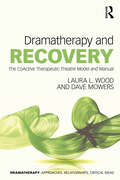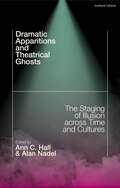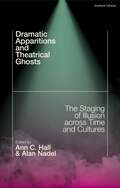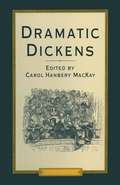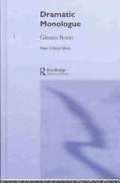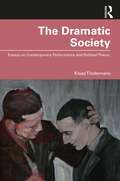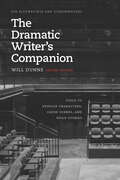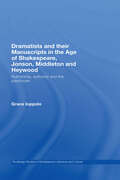- Table View
- List View
Dramatherapy: The Nature of Interruption
by Richard Hougham Bryn JonesThis book investigates the nature and phenomena of interruption in ways that have relevance for contemporary dramatherapy practice. It is a timely contribution amidst an ‘age of interruption’ and examines how dramatherapists might respond with agency and discernment in personal, professional and cultural contexts. The writing gathers fresh ideas on how to conceptualise and utilise interruptions artistically, socially and politically. Individual chapters destabilise traditional conceptions of verbal and behavioural models of psychotherapy and offer a new vision based in the arts and philosophy. There are examples of interruption in practice contexts, augmented by extracts from case studies and clinical vignettes. The book is not a sequential narrative – rather a bricolage of ideas, which create intersections between aesthetics, language and the imagination. New and international voices in dramatherapy emerge to generate a radical immanence; from Greek shadow puppetry to the Japanese horticultural practice of Shakkei; from the appearance of ‘ghosts’ in the consulting room to images in the third space of the therapeutic encounter, interruptions are reckoned with as relevant and generative. This book will be of interest to students, arts therapists, scholars and practitioners, who are concerned with the nature of interruption and how dramatherapy can offer a means of active engagement.
Dramatherapy and Recovery: The CoActive Therapeutic Theatre Model and Manual (ISSN)
by Laura L. Wood Dave MowersDramatherapy and Recovery offers a comprehensive and groundbreaking approach to harnessing the power of theater in the recovery process through the use of playmaking and performance.This manual is based on the CoActive Therapeutic Theater (CoATT) model, the first of its kind to be meticulously documented and standardized. With its emphasis on replicability and measurable outcomes, the CoATT model is brought to life through annotated scripts and progress notes extracted from past productions involving diverse populations, including those with eating disorders, aphasia, schizophrenia, and substance abuse disorder. The authors illuminate the six principles that distinguish CoATT from other therapeutic and applied theater approaches. The chapters provide a structured framework compromising seven defined movements that act as attainable milestones for participants guided towards producing a powerful and transformative public performance.Dramatherapy and Recovery equips practitioners of dramatherapy, counseling arts in health, applied theater, community theater, and other mental health disciplines with the tools needed to create transformative performances with individuals reconnecting with the community after treatment.
Dramatherapy and Recovery: The CoActive Therapeutic Theatre Model and Manual (ISSN)
by Laura L. Wood Dave MowersDramatherapy and Recovery offers a comprehensive and groundbreaking approach to harnessing the power of theater in the recovery process through the use of playmaking and performance.This manual is based on the CoActive Therapeutic Theater (CoATT) model, the first of its kind to be meticulously documented and standardized. With its emphasis on replicability and measurable outcomes, the CoATT model is brought to life through annotated scripts and progress notes extracted from past productions involving diverse populations, including those with eating disorders, aphasia, schizophrenia, and substance abuse disorder. The authors illuminate the six principles that distinguish CoATT from other therapeutic and applied theater approaches. The chapters provide a structured framework compromising seven defined movements that act as attainable milestones for participants guided towards producing a powerful and transformative public performance.Dramatherapy and Recovery equips practitioners of dramatherapy, counseling arts in health, applied theater, community theater, and other mental health disciplines with the tools needed to create transformative performances with individuals reconnecting with the community after treatment.
Dramatherapy and Social Theatre: Necessary Dialogues
by Sue JenningsDramatherapy and Social Theatre: Necessary Dialogues considers the nature of drama, theatre and dramatherapy, examining how dramatherapy has evolved over the past decade and how the relationship between dramatherapy and social theatre has developed as a result. In this book Sue Jennings brings together international dramatherapists and theatre practitioners to challenge, clarify, describe and debate some of the theoretical and practical issues in dramatherapy and social theatre. Contributors cover topics including: dramatherapy in communities ground rules and definitions cross-cultural perspectives dramatherapy with adoptive and foster families research with professional actors. Dramatherapy and Social Theatre is illustrated throughout with case vignettes providing examples of how theatre and therapeutic processes can be brought together. It will be valuable reading for both professionals and students involved in dramatherapy and theatre studies.
Dramatherapy and Social Theatre: Necessary Dialogues
by Sue JenningsDramatherapy and Social Theatre: Necessary Dialogues considers the nature of drama, theatre and dramatherapy, examining how dramatherapy has evolved over the past decade and how the relationship between dramatherapy and social theatre has developed as a result. In this book Sue Jennings brings together international dramatherapists and theatre practitioners to challenge, clarify, describe and debate some of the theoretical and practical issues in dramatherapy and social theatre. Contributors cover topics including: dramatherapy in communities ground rules and definitions cross-cultural perspectives dramatherapy with adoptive and foster families research with professional actors. Dramatherapy and Social Theatre is illustrated throughout with case vignettes providing examples of how theatre and therapeutic processes can be brought together. It will be valuable reading for both professionals and students involved in dramatherapy and theatre studies.
Dramatic Adventures in Rhetoric: A Guide for Actors, Directors and Playwrights (The Actor's Toolkit)
by Giles Taylor Phlip WilsonA practical and accessible guide to identifying and using rhetorical devices in plays, past and present. An unprecedented reference book for actors, directors, playwrights and teachers – written by practitioners for practitioners. Giles Taylor and Philip Wilson address in detail – yet in straightforward terms – the many different rhetorical forms used in drama, and enable the reader to analyze their effect. The study of rhetoric can give an insight into character and intention, thereby unlocking a text for a performer or director, and providing inspiration for contemporary playwrights. Dramatic Adventures in Rhetoric may be read from cover to cover, or it may be dipped into: it is both an analytic tool and a reference for use in the rehearsal room or for study purposes. The book includes hundreds of examples, from almost 300 plays by 140 playwrights from the Renaissance to the modern day.
Dramatic Apparitions and Theatrical Ghosts: The Staging of Illusion across Time and Cultures
by Ann C. Hall and Alan NadelGhosts haunt the stages of world theatre, appearing in classical Greek drama through to the plays of 21st-century dramatists. Tracing the phenomenon across time and in different cultures, the chapters collected here examine their representation, dramatic function, and what they may tell us about the belief systems of their original audiences and the conditions of theatrical production. As illusions of illusions, they foreground many dramatic themes common to a wide variety of periods and cultures. Arranged chronologically, this collection examines how ghosts represent political change in Athenian culture in three plays by Aeschylus; their function in traditional Japanese drama; the staging of the supernatural in the dramatic liturgy of the early Middle Ages; ghosts within the dramatic works of Middleton, George Peele, and Christopher Marlowe, and the technologies employed in the 18th and 19th centuries to represent the supernatural on stage. Coverage of the dramatic representation of ghosts in the 20th and 21st centuries includes studies of Noël Coward's Blithe Spirit, August Wilson's Pittsburgh Cycle, plays by Sam Shepard, David Mamet, and Sarah Ruhl, Paddy Chayefsky's The Tenth Man, Suzan-Lori Parks' Topdog/Underdog, and the spectral imprint of Shakespeare's ghosts in the Irish drama of Marina Carr, Martin McDonagh, William Butler Yeats, and Samuel Beckett. The volume closes by examining three contemporary American indigenous plays by Anishinaabe author, Alanis King.
Dramatic Apparitions and Theatrical Ghosts: The Staging of Illusion across Time and Cultures
Ghosts haunt the stages of world theatre, appearing in classical Greek drama through to the plays of 21st-century dramatists. Tracing the phenomenon across time and in different cultures, the chapters collected here examine their representation, dramatic function, and what they may tell us about the belief systems of their original audiences and the conditions of theatrical production. As illusions of illusions, they foreground many dramatic themes common to a wide variety of periods and cultures. Arranged chronologically, this collection examines how ghosts represent political change in Athenian culture in three plays by Aeschylus; their function in traditional Japanese drama; the staging of the supernatural in the dramatic liturgy of the early Middle Ages; ghosts within the dramatic works of Middleton, George Peele, and Christopher Marlowe, and the technologies employed in the 18th and 19th centuries to represent the supernatural on stage. Coverage of the dramatic representation of ghosts in the 20th and 21st centuries includes studies of Noël Coward's Blithe Spirit, August Wilson's Pittsburgh Cycle, plays by Sam Shepard, David Mamet, and Sarah Ruhl, Paddy Chayefsky's The Tenth Man, Suzan-Lori Parks' Topdog/Underdog, and the spectral imprint of Shakespeare's ghosts in the Irish drama of Marina Carr, Martin McDonagh, William Butler Yeats, and Samuel Beckett. The volume closes by examining three contemporary American indigenous plays by Anishinaabe author, Alanis King.
Dramatic Character in the English Romantic Age (PDF)
by Joseph W. Donohue Jr.This was the age of the star. For the first time in the history of the theater, the playwright took second place to the actor; the interpretation of the role assumed primary importance in a assessing a performance. It was Mr. Kean's Hamlet first, and Mr. Shakespeare's second.What effects did this highly subjective, interpretive emphasis have on the drama? Where did it originate and how did it evolve? These questions are considered at length in the author's analysis of the nature of Romanticism itself as revealed in essays, novels, criticism, and by the actors themselves. The Jacobean origins of this revolutionary period are reviewed, followed by a close scrutiny of the critical writing of such contemporary thinkers as Hazlitt, Coleridge, Shelley, and Keats. This entirely new concept provides an important link between the practical theater and the contemporary philosophical thought of the time.Originally published in 1970.The Princeton Legacy Library uses the latest print-on-demand technology to again make available previously out-of-print books from the distinguished backlist of Princeton University Press. These editions preserve the original texts of these important books while presenting them in durable paperback and hardcover editions. The goal of the Princeton Legacy Library is to vastly increase access to the rich scholarly heritage found in the thousands of books published by Princeton University Press since its founding in 1905.
Dramatic Critic (1922-1939): Selected Reviews (1922-1939)
by Charles MorganCharles Morgan was the dramatic critic of The Times for most of the years between 1922 and 1939.The reviews for this small selection are taken from thousands written for The Times and from his weekly articles for The New York Times on the London theatre. Morgan was widely regarded as the most influential critic of his day. His fellow critic, James Agate, wrote ‘When Charles is on form he has us all whacked.’ Though most werewritten overnight for the following day’s paper, they were given spaceallowed to no modern critic. Beautifully written, they bring to life many of the great actors and actresses and the dramatists, old and new, as the theatre moved from the frivolous Twenties into the shadow of another war and towards the modern theatre of today. As they mirror the development of English theatrical taste in the interwar years, they are as much a delight to read, both witty and erudite, as they are an important historical record.
Dramatic Geography: Romance, Intertheatricality, and Cultural Encounter in Early Modern Mediterranean Drama (Early Modern Literary Geographies)
by Laurence PublicoverFocusing on early modern plays which stage encounters between peoples of different cultures, this book asks how a sense of geographical location was created in early modern theatres that featured minimal scenery. While previous studies have stressed these plays' connections to a historical Mediterranean in which England was increasingly involved, this volume demonstrates how their dramatic geography was shaped through a literary and theatrical heritage. Reading canonical plays including The Merchant of Venice, The Jew of Malta, and The Tempest alongside lesser-known dramas such as Soliman and Perseda, Guy of Warwick, and The Travels of the Three English Brothers, Dramatic Geography illustrates how early modern dramatists staging foreign worlds drew upon a romance tradition dating back to the medieval period, and how they responded to one another's plays to create an 'intertheatrical geography'. These strategies shape the plays' wider meanings in important ways, and could only have operated within the theatrical environment peculiar to early modern London: one in which playwrights worked in close proximity, in one instance perhaps even living together while composing Mediterranean dramas, and one where they could expect audiences to respond to subtle generic and intertextual negotiations. In reassessing this group of plays, Laurence Publicover brings into conversation scholarship on theatre history, cultural encounter, and literary geography; the book also contributes to current debates in early modern studies regarding the nature of dramatic authorship, the relationship between genre and history, and the continuities that run between the fourteenth and seventeenth centuries.
Dramatic Geography: Romance, Intertheatricality, and Cultural Encounter in Early Modern Mediterranean Drama (Early Modern Literary Geographies)
by Laurence PublicoverFocusing on early modern plays which stage encounters between peoples of different cultures, this book asks how a sense of geographical location was created in early modern theatres that featured minimal scenery. While previous studies have stressed these plays' connections to a historical Mediterranean in which England was increasingly involved, this volume demonstrates how their dramatic geography was shaped through a literary and theatrical heritage. Reading canonical plays including The Merchant of Venice, The Jew of Malta, and The Tempest alongside lesser-known dramas such as Soliman and Perseda, Guy of Warwick, and The Travels of the Three English Brothers, Dramatic Geography illustrates how early modern dramatists staging foreign worlds drew upon a romance tradition dating back to the medieval period, and how they responded to one another's plays to create an 'intertheatrical geography'. These strategies shape the plays' wider meanings in important ways, and could only have operated within the theatrical environment peculiar to early modern London: one in which playwrights worked in close proximity, in one instance perhaps even living together while composing Mediterranean dramas, and one where they could expect audiences to respond to subtle generic and intertextual negotiations. In reassessing this group of plays, Laurence Publicover brings into conversation scholarship on theatre history, cultural encounter, and literary geography; the book also contributes to current debates in early modern studies regarding the nature of dramatic authorship, the relationship between genre and history, and the continuities that run between the fourteenth and seventeenth centuries.
The Dramatic Literature of Nawal El Saadawi: God Resigns and Isis
by Nawal El SaadawiNawal El Saadawi's most recent play, God Resigns at the Summit Meeting, created an uproar in her native Egypt. On the basis of the title alone, officials declared the work heretical and charged El Saadawi with insulting the "Almighty God", not just Islam. Her prosecutors requested that all her books be destroyed, that she be arrested on return to Egypt and her Egyptian nationality be revoked. In the play, the prophets and great women gather for a meeting with God. Satan arrives to tender his resignation but neither Jesus, nor Mohammad, nor Moses are willing to replace him. Finally, God himself resigns. The second play in this collection is Isis, a critique of the discriminatory rules that control women, the daughters of Isis. Both God Resigns and Isis incorporate key themes to El Saadawi's work: that all religions are inimical to women and the poor, that the oppression of women is reprehensible and not uniquely characteristic of the Middle East or the ''Third World'', and that free speech is fundamental to any society. "El Saadawi writes with directness and passion" New York Times Book Review 'A poignant and brave writer' Marie Claire 'The leading spokeswoman on the status of women in the Arab World' Guardian 'More than any other woman, El Saadawi has come to embody the trials of Arab feminism.' San Francisco Chronicle
Dramatic Monologue (The New Critical Idiom)
by Glennis ByronThe dramatic monologue is traditionally associated with Victorian poets such as Robert Browning and Alfred Tennyson, and is generally considered to have disappeared with the onset of modernism in the twentieth century. Glennis Byron unravels its history and argues that, contrary to belief, the monologue remains popular to this day. This far-reaching and neatly structured volume: * explores the origins of the monologue and presents a history of definitions of the term * considers the monologue as a form of social critique * explores issues at play in our understanding of the genre, such as subjectivity, gender and politics * traces the development of the genre through to the present day. Taking as example the increasingly politicized nature of contemporary poetry, the author clearly and succinctly presents an account of the monologue's growing popularity over the past twenty years.
Dramatic Monologue (The New Critical Idiom)
by Glennis ByronThe dramatic monologue is traditionally associated with Victorian poets such as Robert Browning and Alfred Tennyson, and is generally considered to have disappeared with the onset of modernism in the twentieth century. Glennis Byron unravels its history and argues that, contrary to belief, the monologue remains popular to this day. This far-reaching and neatly structured volume: * explores the origins of the monologue and presents a history of definitions of the term * considers the monologue as a form of social critique * explores issues at play in our understanding of the genre, such as subjectivity, gender and politics * traces the development of the genre through to the present day. Taking as example the increasingly politicized nature of contemporary poetry, the author clearly and succinctly presents an account of the monologue's growing popularity over the past twenty years.
The Dramatic Society: Essays on Contemporary Performance and Political Theory
by Klaas TindemansAll societies are, by their very nature, dramatic. They present themselves, especially for those who want to look back in time, as a fascinating and confusing whole of theatrical events and constructions. Sometimes the theatre itself succeeds in capturing that fascination and confusion. This book describes the dramatic society in the form of case studies that link politics, history and culture. The Dramatic Society uses selected plays to examine specific moments in history. Its range of subjects are extremely diverse, including Medea as an icon of terrorism, a choreography based upon Shakespeare’s As You Like It, horror movies about the German unification, a truth commission dealing with "human zoos", and the reconstruction of Ai Weiwei’s troubles with the tax authorities. This collection of insightful essays deals with theatrical performances – including happenings, installations and movies – of the past fifty years, with every chapter attempting to link artistic events with politics and political theory, from Hannah Arendt to Slavoj Žižek. This is a revealing assessment of the ways in which drama and politics become intertwined, offering crucial insights for scholars and students of theatre studies, performance studies, contemporary politics and cultural studies.
The Dramatic Society: Essays on Contemporary Performance and Political Theory
by Klaas TindemansAll societies are, by their very nature, dramatic. They present themselves, especially for those who want to look back in time, as a fascinating and confusing whole of theatrical events and constructions. Sometimes the theatre itself succeeds in capturing that fascination and confusion. This book describes the dramatic society in the form of case studies that link politics, history and culture. The Dramatic Society uses selected plays to examine specific moments in history. Its range of subjects are extremely diverse, including Medea as an icon of terrorism, a choreography based upon Shakespeare’s As You Like It, horror movies about the German unification, a truth commission dealing with "human zoos", and the reconstruction of Ai Weiwei’s troubles with the tax authorities. This collection of insightful essays deals with theatrical performances – including happenings, installations and movies – of the past fifty years, with every chapter attempting to link artistic events with politics and political theory, from Hannah Arendt to Slavoj Žižek. This is a revealing assessment of the ways in which drama and politics become intertwined, offering crucial insights for scholars and students of theatre studies, performance studies, contemporary politics and cultural studies.
Dramatic Spaces: Scenography and Spectatorial Perceptions
by Jennifer LowFor literary scholars, plays are texts; for scenographers, plays are performances. Yet clearly a drama is both text and performance. Dramatic Spaces examines period-specific stage spaces in order to assess how design shaped the thematic and experiential dimensions of plays. This book highlights the stakes of the debate about spatiality and the role of the spectator in the auditorium – if audience members are co-creators of the drama, how do they contribute? The book investigates: Roman comedy and Shakespearean dramas in which the stage-space itself constituted the primary scenographic element and actors’ bodies shaped the playing space more than did sets or props the use of paid applauders in nineteenth-century Parisian theaters and how this practice reconfigured theatrical space transactions between stage designers and spectators, including work by László Moholy-Nagy, William Ritman, and Eiko Ishioka Dramatic Spaces aims to do for stage design what reader-response criticism has done for the literary text, with specific case studies on Coriolanus, The Comedy of Errors, Romeo and Juliet, Tales of Hoffman, M. Butterfly and Tiny Alice exploring the audience’s contribution to the construction of meaning.
Dramatic Spaces: Scenography and Spectatorial Perceptions
by Jennifer LowFor literary scholars, plays are texts; for scenographers, plays are performances. Yet clearly a drama is both text and performance. Dramatic Spaces examines period-specific stage spaces in order to assess how design shaped the thematic and experiential dimensions of plays. This book highlights the stakes of the debate about spatiality and the role of the spectator in the auditorium – if audience members are co-creators of the drama, how do they contribute? The book investigates: Roman comedy and Shakespearean dramas in which the stage-space itself constituted the primary scenographic element and actors’ bodies shaped the playing space more than did sets or props the use of paid applauders in nineteenth-century Parisian theaters and how this practice reconfigured theatrical space transactions between stage designers and spectators, including work by László Moholy-Nagy, William Ritman, and Eiko Ishioka Dramatic Spaces aims to do for stage design what reader-response criticism has done for the literary text, with specific case studies on Coriolanus, The Comedy of Errors, Romeo and Juliet, Tales of Hoffman, M. Butterfly and Tiny Alice exploring the audience’s contribution to the construction of meaning.
The Dramatic Writer's Companion, Second Edition: Tools to Develop Characters, Cause Scenes, and Build Stories (Chicago Guides to Writing, Editing, and Publishing)
by Will DunneIn just eight years, The Dramatic Writer’s Companion has become a classic among playwrights and screenwriters. Thousands have used its self-contained character, scene, and story exercises to spark creativity, hone their writing, and improve their scripts. Having spent decades working with dramatists to refine and expand their existing plays and screenplays, Dunne effortlessly blends condensed dramatic theory with specific action steps—over sixty workshop-tested exercises that can be adapted to virtually any individual writing process and dramatic script. Dunne’s in-depth method is both instinctual and intellectual, allowing writers to discover new actions for their characters and new directions for their stories. The exercises can be used by those just starting the writing process and by those who have scripts already in development. With each exercise rooted in real-life issues from Dunne’s workshops, readers of this companion will find the combined experiences of more than fifteen hundred workshops in a single guide. This second edition is fully aligned with a brand-new companion book, Character, Scene, and Story, which offers forty-two additional activities to help writers more fully develop their scripts. The two books include cross-references between related exercises, though each volume can also stand alone. No ordinary guide to plotting, this handbook centers on the principle that character is key. “The character is not something added to the scene or to the story,” writes Dunne. “Rather, the character is the scene. The character is the story.” With this new edition, Dunne’s remarkable creative method will continue to be the go-to source for anyone hoping to take their story to the stage.
The Dramatic Writer's Companion, Second Edition: Tools to Develop Characters, Cause Scenes, and Build Stories (Chicago Guides to Writing, Editing, and Publishing)
by Will DunneIn just eight years, The Dramatic Writer’s Companion has become a classic among playwrights and screenwriters. Thousands have used its self-contained character, scene, and story exercises to spark creativity, hone their writing, and improve their scripts. Having spent decades working with dramatists to refine and expand their existing plays and screenplays, Dunne effortlessly blends condensed dramatic theory with specific action steps—over sixty workshop-tested exercises that can be adapted to virtually any individual writing process and dramatic script. Dunne’s in-depth method is both instinctual and intellectual, allowing writers to discover new actions for their characters and new directions for their stories. The exercises can be used by those just starting the writing process and by those who have scripts already in development. With each exercise rooted in real-life issues from Dunne’s workshops, readers of this companion will find the combined experiences of more than fifteen hundred workshops in a single guide. This second edition is fully aligned with a brand-new companion book, Character, Scene, and Story, which offers forty-two additional activities to help writers more fully develop their scripts. The two books include cross-references between related exercises, though each volume can also stand alone. No ordinary guide to plotting, this handbook centers on the principle that character is key. “The character is not something added to the scene or to the story,” writes Dunne. “Rather, the character is the scene. The character is the story.” With this new edition, Dunne’s remarkable creative method will continue to be the go-to source for anyone hoping to take their story to the stage.
The Dramatic Writer's Companion, Second Edition: Tools to Develop Characters, Cause Scenes, and Build Stories (Chicago Guides to Writing, Editing, and Publishing)
by Will DunneIn just eight years, The Dramatic Writer’s Companion has become a classic among playwrights and screenwriters. Thousands have used its self-contained character, scene, and story exercises to spark creativity, hone their writing, and improve their scripts. Having spent decades working with dramatists to refine and expand their existing plays and screenplays, Dunne effortlessly blends condensed dramatic theory with specific action steps—over sixty workshop-tested exercises that can be adapted to virtually any individual writing process and dramatic script. Dunne’s in-depth method is both instinctual and intellectual, allowing writers to discover new actions for their characters and new directions for their stories. The exercises can be used by those just starting the writing process and by those who have scripts already in development. With each exercise rooted in real-life issues from Dunne’s workshops, readers of this companion will find the combined experiences of more than fifteen hundred workshops in a single guide. This second edition is fully aligned with a brand-new companion book, Character, Scene, and Story, which offers forty-two additional activities to help writers more fully develop their scripts. The two books include cross-references between related exercises, though each volume can also stand alone. No ordinary guide to plotting, this handbook centers on the principle that character is key. “The character is not something added to the scene or to the story,” writes Dunne. “Rather, the character is the scene. The character is the story.” With this new edition, Dunne’s remarkable creative method will continue to be the go-to source for anyone hoping to take their story to the stage.
The Dramatic Writer's Companion, Second Edition: Tools to Develop Characters, Cause Scenes, and Build Stories (Chicago Guides to Writing, Editing, and Publishing)
by Will DunneIn just eight years, The Dramatic Writer’s Companion has become a classic among playwrights and screenwriters. Thousands have used its self-contained character, scene, and story exercises to spark creativity, hone their writing, and improve their scripts. Having spent decades working with dramatists to refine and expand their existing plays and screenplays, Dunne effortlessly blends condensed dramatic theory with specific action steps—over sixty workshop-tested exercises that can be adapted to virtually any individual writing process and dramatic script. Dunne’s in-depth method is both instinctual and intellectual, allowing writers to discover new actions for their characters and new directions for their stories. The exercises can be used by those just starting the writing process and by those who have scripts already in development. With each exercise rooted in real-life issues from Dunne’s workshops, readers of this companion will find the combined experiences of more than fifteen hundred workshops in a single guide. This second edition is fully aligned with a brand-new companion book, Character, Scene, and Story, which offers forty-two additional activities to help writers more fully develop their scripts. The two books include cross-references between related exercises, though each volume can also stand alone. No ordinary guide to plotting, this handbook centers on the principle that character is key. “The character is not something added to the scene or to the story,” writes Dunne. “Rather, the character is the scene. The character is the story.” With this new edition, Dunne’s remarkable creative method will continue to be the go-to source for anyone hoping to take their story to the stage.
Dramatists and their Manuscripts in the Age of Shakespeare, Jonson, Middleton and Heywood: Authorship, Authority and the Playhouse (Routledge Studies in Renaissance Literature and Culture)
by Grace IoppoloThis book presents new evidence about the ways in which English Renaissance dramatists such as William Shakespeare, Ben Jonson, Thomas Heywood, John Fletcher and Thomas Middleton composed their plays and the degree to which they participated in the dissemination of their texts to theatrical audiences. Grace Ioppolo argues that the path of the transmission of the text was not linear, from author to censor to playhouse to audience - as has been universally argued by scholars - but circular. Extant dramatic manuscripts, theatre records and accounts, as well as authorial contracts, memoirs, receipts and other archival evidence, are used to prove that the text returned to the author at various stages, including during rehearsal and after performance. This monograph provides much new information and case studies, and is a fascinating contribution to the fields of Shakespeare studies, English Renaissance drama studies, manuscript studies, textual study and bibliography and theatre history.

